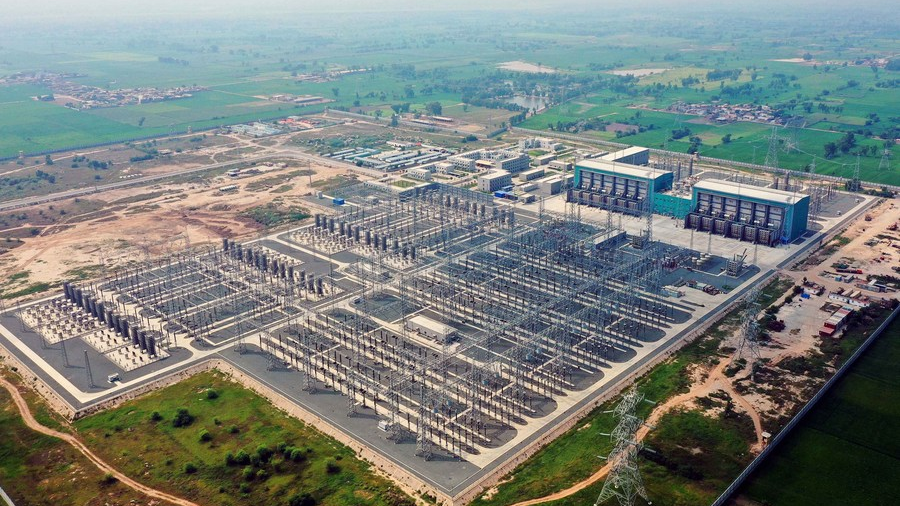
Internally displaced people wade through floodwaters after heavy monsoon rains, Balochistan, Pakistan, September 8, 2022. /CFP
Internally displaced people wade through floodwaters after heavy monsoon rains, Balochistan, Pakistan, September 8, 2022. /CFP
Editor's note: Ruqiya Anwar, a PhD scholar of Media and Communication Studies from Pakistan, is a researcher and socio-political analyst. The article reflects the author's opinions and not necessarily the views of CGTN.
The Belt and Road Initiative (BRI) is anticipated to be the 21st century's largest infrastructure development programme. It encompasses more than 80 nations, and total investments are projected to range between $1 trillion and $8.5 trillion. The BRI has stimulated industrialization and widened economic opportunities around the world.
The prospect of enhanced regional connectivity, infrastructure development, an integrated transportation system, economic corridors, major industrialization, and poverty eradication has increased. It aims to improve regional and cross-regional economic growth and trade integration across Central Asia, South Asia, West Asia, and East Asia.
Notably, China's strategic partnership with Pakistan is unwavering, and Pakistan's location along the Belt and Road makes it an essential economic hub. In addition, Pakistan is one of the representatives of the developing world because it shares many of the same sociopolitical characteristics important for economic development, such as poor governance, low literacy rates, inadequate infrastructure, and a history of political instability.
In recent years, Pakistan has been hit by several natural disasters, including devastating floods, droughts, and cyclones. These disasters have claimed thousands of lives, wiped entire communities, and wrecked livelihoods and infrastructure. Moreover, Pakistan is one of the most vulnerable countries in the world to the consequences of climate change, as climate change increases the likelihood that these and other natural hazards may rise in frequency and intensity in the future decades.
Additionally, the reduced agricultural output, higher variability in water supply, increased coastline erosion and seawater incursion, and increased frequency of extreme climatic events are only a few of Pakistan's many predicted consequences of climate change. Therefore, the only way to effectively combat these threats is to incorporate climate change into national strategy and policy and make climate-aware investments in infrastructure, enterprises, and human capital.
Experts have urged the Pakistani government to improve flood forecasting and prediction by speeding up early warning and monitoring and bolstering employee training and further emphasized the importance of regional and international cooperation to improve early warning capabilities.
In this regard, as part of the BRI, Pakistan and China have set up a lidar station to monitor the local climate. Researchers and scientists can work together under this lidar network to establish a regional weather monitoring system, which will aid in the creation of a weather disaster warning system. Lidar, the most advanced radar system, has begun operations in Peshawar, Pakistan, to collect data on the China-Pakistan Economic Corridor (CPEC) area's clouds, aerosols, temperature, and humidity. It will provide fundamental information for weather and environmental disaster forecasting and global warming analysis. The China-Pakistan Economic Corridor is an integral aspect of the BRI, which has revolutionized Pakistan's socioeconomic landscape by redeveloping infrastructure and resolving the energy issue.

Lahore Converter Station under the China-Pakistan Economic Corridor, Punjab, Pakistan, September 6, 2021. /Xinhua
Lahore Converter Station under the China-Pakistan Economic Corridor, Punjab, Pakistan, September 6, 2021. /Xinhua
The lidar network also comprises eight stations in northwest China's Gansu Province and Xinjiang Uygur Autonomous Region, with one of those sites being in Peshawar. Again, the correct prediction of extreme weather occurrences benefits from this.
Significantly, according to Professor Huang Zhongwei, a professor with the Lanzhou University in northwest China's Gansu province, the lidar station at the University of Peshawar is the most cutting-edge climate and environment observation station in Pakistan. Moreover, scientists have developed a regional comprehensive weather monitoring system by combining the lidar network with weather satellites, creating a high-quality database, creating a weather disaster warning system, and fulfilling the requirements of constructing new energy, transportation, and other crucial infrastructure. Therefore, lidar networks might be useful in evaluating and addressing Peshawar's air quality problems while monitoring the resulting effects on human health and the environment.
Most importantly, it would greatly ameliorate the current situation of insufficient observational data on air pollutants, dust particles, water vapour, and meteorological elements in the regions along the CPEC. The primary dust belt across the world's arid and semi-arid regions runs parallel to the Silk Road Economic Belt, where the lidar network is located.
Similarly, the greening of the BRI, a China-led initiative, entails development initiatives aligned with the 2030 United Nations Sustainable Development Goals targets that also present investment opportunities favorable to climate action. The Belt and Road Initiative International Green Development Coalition (BRIGC) is a new strategy for enhancing the BRI's environmental sustainability. It was introduced at the April 2019, Beijing Belt and Road Forum for International Cooperation.
Its goal is to include policy coordination, infrastructure building, trade, financial integration, and cultural exchanges into sustainable development, environmental sustainability, international standards, and best practices to ensure that the BRI brings long-term green and sustainable development to all concerned countries in support of the 2030 Agenda for Sustainable Development. The United Nations Environment Programme has established what it calls "The Coalition," an open, inclusive, and voluntary international network that brings together the environmental expertise of all partners.
Hence, the fight against climate change requires concerted efforts from nations worldwide. As the Professor Huang Zhongwei of Lanzhou University and leader of the development team for China's multiband Raman-fluorescence lidar remarked, "It is about the fate of all mankind. "Undoubtedly, the lidar network can play a significant role in bolstering climate resilience. We can envision this technology as a valuable asset in Pakistan's ongoing fight to become more climate-resilient.
(If you want to contribute and have specific expertise, please contact us at opinions@cgtn.com. Follow @thouse_opinions on Twitter to discover the latest commentaries in the CGTN Opinion Section.)

